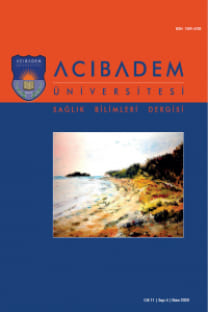Obstrüktif Uyku Apneli Hastaların Eritrosit Lizatlarında O-Alkyl/O-Alkenil Gliserolipid Oranlarının Araştırılması
Investigation of O-Alkyl/O-Alkenyl Glycerolipid Ratios in Erythrocyte Lysates of Patients with Obstructive Sleep Apnea
___
- 1. Zhou L, Chen P, Peng Y, et al. Role of oxidative stress in the neurocognitive dysfunction of obstructive sleep apnea syndrome. Oxid Med Cell Longev. 2016;(2016):15.
- 2. Jaspers T, Morrell M, Simonds A, et al. The role of hypoxia and the circadian rhythm in sleep apnea. Eur. Respir. J. 2015;46 (issue suppl 59):OA298.
- 3. Davies SK, Ang JE, Revell VL, et al. Effect of sleep deprivation on the human metabolome. Proc Natl Acad Sci USA. 2014;111(29):10761-6.
- 4. Weljie AM, Meerlo P, Goel N, et al. Oxalic acid and diacylglycerol 36:3 are cross-species markers of sleep debt. PNAS. 2015;112(8):2569-74.
- 5. Chua ECP, Shui G, Cazenave-Gassiot A, et al. Changes in plasma lipids during exposure to total sleep deprivation. Sleep. 2015;38(11):1683-91.
- 6. Lee TC. Biosynthesis and possible biological functions of plasmalogens. Biochim Biophys Acta. 1998: 1394(2-3):129-145.
- 7. Watschinger W, Werner ER. Orphan enzymes in ether lipid metabolism. Biochimie. 2013; 95(1): 59-65.
- 8. Ford DA. Biosynthesis of plasmalogens in mammalian cells and their accelerated catabolism during cellular activation. In:Gross RW, editor. Advances in Lipobiology, USA: JAI Press, 1996: (1):176.
- 9. Su XQ, Wang J, Sinclair AJ. Plasmalogens and Alzheimer’s disease: a review. Lipids in Health and Disease. (2019) 18:100.
- 10. Berry RB, Budhiraja R, Gottlieb DJ, et al. Rules for scoring respiratory events in sleep: update of the 2007 AASM manual for the scoring of sleep and associated events. Deliberations of the sleep apnea definitions task force of the American Academy of Sleep Medicine. J Clin Sleep Med. 2012;8(5):597-619).
- 11. Bligh EG, Dyer WJ. A rapid method of total lipid extraction and purification. Can J Biochem Physiol. 1959; 37(8):911-7.
- 12. Snyder F. Thin-layer chromatographic behavior of glycerolipid analogs containing ether, ester, hydroxyl, and ketone groupings. J. Chromatogr. 1973;82(I 973):7-14.
- 13. Senaratna CV, Perret JL, Lodge CL, et al. Prevalence of obstructive sleep apnea in thegeneral population: A systematic review. Sleep Med Rev. 2017;34: 70-81).
- 14. Stansbury RC, Strollo PJ. Clinical manifestations of sleep apnea. J Thorac Dis. 2015;7(9): E298-E310.
- 15. Snyder F. Ether lipids chemistry and biology. New York and London: Academic Press, 1972: 25-50.
- 16. Braverman NE, Moser AB. Functions of plasmalogen lipids in health and disease. BBA. 2012;1822(9):1442-52.
- 17. Maeba R, Nishimukai M, Sakasegawa SI, et al. Plasma/serum plasmalogens: methods of analysis and clinical significance. Advances in Clinical Chemistry, 1st ed. Elsevier Inc 2015: (70):31-94.
- 18. Diagne A, Fauvel J, Record M, et al. Studies on ether phospholipids II. comparative composition of various tissues from human, rat and guinea pig. BBA. 1984;793(2):221-31.
- 19. Connor WE, Lin DS, Thomas G, et al. Abnormal phospholipid molecular species of erythrocytes in sickle cell anemia. J Lipid Res. 1997;38:2516-28.
- 20. Moller-Levet CS, Archer SN, Bucca G, et al. Effects of insufficient sleep on circadian rhythmicity and expression amplitude of the human blood transcriptome. Proc Natl Acad Sci. 2013;110:E1132-E113241.
- 21. Huang W, Ramsey KM, Marcheva B, et al. Circadian rhythms, sleep, and metabolism. Neurobiology. 2011;121(6):2133-41.
- 22. Osipenko AN. Change of plasmalogen content of red blood cells in myocardial hypoxia and acidosis. Acta Cardiologica. 2018;73(1):61-8.
- 23. Haase VH. Hypoxic regulation of erythropoiesis and iron metabolism. Am J Physiol Renal Physiol. 2010;299(1):F1–13.
- 24. Maeba R, Maeda T, Kinoshita M, et al. Plasmalogens in human serum positively correlate with high- density lipoprotein and decrease with aging. J Atheroscler Thromb. 2007;Feb;14(1):12-8.
- 25. Wang-Sattler R, Yu Y, Mittelstrass K, et al. Metabolic profiling reveals distinct variations linked to nicotine consumption in humans -first results from the kora study. PLoS ONE. 2008;3(12): e3863.
- 26. Meikle PJ, Wong G, Barlow CK, et al. Plasma lipid profiling shows similar associations with prediabetes and Type 2 Diabetes. PLoS ONE. 2013:8(9): e74341.
- 27. Moser AB, Steinberg SJ, Watkins PA, et al. Human and great ape red blood cells differ in plasmalogen levels and composition. Lipids Health Dis. 2011;Jun 17;10:101.
- 28. Ikuta A, Sakurai T, Nishi-Mukai M, et al. Composition of plasmalogens in serum lipoproteins from patients with nonalcoholic steatohepatitis and their susceptibility to oxidation. Clinica Chimica Acta. 2019; 493: 1-7.
- 29. Mawatari S, Katafuchi T, Miake K, et al. Dietary plasmalogen increases erythrocyte membrane plasmalogen in rats. Lipids Health Dis. 2012;11(1):161.
- ISSN: 1309-470X
- Yayın Aralığı: Yılda 4 Sayı
- Başlangıç: 2010
- Yayıncı: ACIBADEM MEHMET ALİ AYDINLAR ÜNİVERSİTESİ
COVID-19 Pnömonisi Nedeni ile Yatarak Tedavi Gören Hastalarda Aneminin Klinik Sonuçlara Etkisi
Hilal KURTOĞLU GÜMÜŞEL, Burak PAMUKÇU, Selçuk GÖRMEZ, Ömer ÖZÇAĞLAN
Hilal ÖZCEBE, Sevil ÇINAR ÖZBAY, Handan BOZTEPE
Ebru KARAZEYBEK, Gülşen AK SÖZER, Rabiye DEMİR IŞIK
The Assessment of Mesenchymal Stem Cells Characteristics in Cultured Amniotic Fluid Cells
Ergenlerin Akran İlişkilerinin Akilli Telefon Bağımlılığına Etkisi
Mehmet Emin ŞANLI, Funda KAVAK
Ergen ve Erişkin Gebeliklerin Sosyodemografik Özellikleri ve Kaygı Düzeylerinin Değerlendirilmesi
Nursel Üstündağ ÖCAL, İskender GÜN
Harika Gözde GÖZÜKARA BAĞ, Tayfun GÜLDÜR, Emine KOÇ, Hilal ERMİŞ, Muhammed DÜNDAR
Çevrimiçi Diyetisyenlik Türkiye’de Pandemi Sonrası Dönemin Yeni Akımı Olabilir Mi?
Romatoid Artrit Yaşam Kalitesi Ölçeklerinin Hastalık Aktivitesine Göre Değerlendirilmesi
